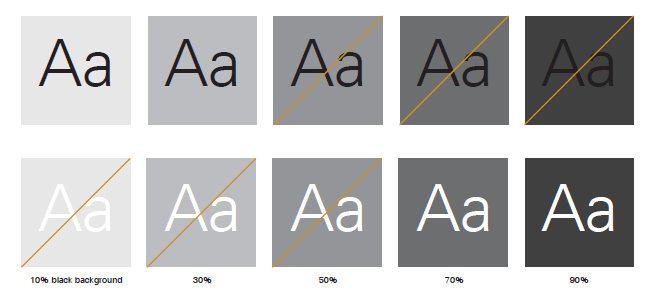4.2 Contrast and Light Reflectance Value
Contrast is the difference between the light reflectance value (LRV) of an object/text/element and the background against which it is observed. It is an essential tool for making text legible, information accessible, products usable and elements of the built environment more visible for people with low vision.
We use contrast and directed lighting to ensure that visitors can differentiate horizontal from vertical surfaces throughout all gallery spaces.
LRV Standard
The CMHR adheres to a 70% contrast difference for all types of typographic installations. Readability is determined by this formula:
- Contrast = [(B1-B2)/B1] x 100, where B1 = LRV of the lighter area and B2 = LRV of the darker area.
Text and Background
We use high contrast visual elements and text in gallery spaces to create a better experience for all visitors. Contrast levels are chosen with consideration for visitors with visual disabilities such as vision loss, colour blindness, or who are dyslexic. We considered the contrast between the text and its background for the entire colour palette range used in our built exhibits.
Throughout the Museum, text appears on solid backgrounds only. We approved specific colours for black and white text to comply with the Museum’s standard of 70% LRV. Figure 4.2.2 includes different combinations of LRVs, ranging from 10% to 90%, to show that a text-to-background contrast of 70% or more ensures text legibility.

To meet our LRV standard, we either placed additional label panels on top of background imagery or used creative techniques to ensure legibility. Graphic ink mixes, such as CMYK and Pantone Solid, do not provide LRVs in built exhibits as the variances of use for these products are too large. In these cases, CMHR uses portable LRV readers such as the Cromocon Meter or the Pantone CAPSURE to provide accurate LRV measurements to ensure visitors with low vision can read text displayed on built exhibits.
For information on contrast and text used in digital exhibits, see the Media Production Standards for Exhibits section of this guide.